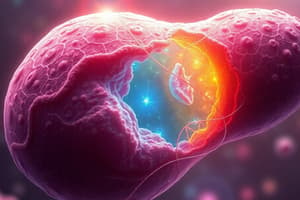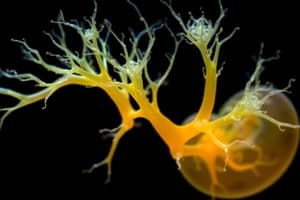Podcast
Questions and Answers
What is the function of the stomodeum in embryonic development?
What is the function of the stomodeum in embryonic development?
- Forms the lens epithelium
- Gives rise to the oral cavity (correct)
- Develops into the optic cup
- Differentiates into the olfactory pit
Which structure forms the optic cup in embryonic development?
Which structure forms the optic cup in embryonic development?
- Oral suckers
- Adhesive gland
- Olfactory placode
- Optic vesicle (correct)
Which structure is derived from the mesencephalon?
Which structure is derived from the mesencephalon?
- Olfactory placode
- Stomodeum
- Endocardium (correct)
- Optic cup
What is the main function of the hypophysis in embryonic development?
What is the main function of the hypophysis in embryonic development?
Which structure is responsible for lens fiber formation in the eye during embryonic development?
Which structure is responsible for lens fiber formation in the eye during embryonic development?
In a 4mm frog embryo, which structure would be clearly recognizable?
In a 4mm frog embryo, which structure would be clearly recognizable?
What is the foremost part of the brain in the neural system differentiation?
What is the foremost part of the brain in the neural system differentiation?
Where are the Olfactory Placodes located?
Where are the Olfactory Placodes located?
Which structure forms the pineal body in the adult brain?
Which structure forms the pineal body in the adult brain?
Which part of the brain is the Otic Placode lateral to?
Which part of the brain is the Otic Placode lateral to?
What is the function of the Otic Lens?
What is the function of the Otic Lens?
What is the cavity formed by the evolution of olfactory pits from olfactory placodes?
What is the cavity formed by the evolution of olfactory pits from olfactory placodes?
Which part of the brain does the Optic vesicle evaginate from?
Which part of the brain does the Optic vesicle evaginate from?
Which part of the head ectoderm forms the lens vesicle?
Which part of the head ectoderm forms the lens vesicle?
What structure projects inside due to invagination?
What structure projects inside due to invagination?
What forms the Prechordal cartilage?
What forms the Prechordal cartilage?
Which cavity is associated with the heart in this context?
Which cavity is associated with the heart in this context?
Where are the Paired pigment invaginations located?
Where are the Paired pigment invaginations located?
What structure defines the anterior/posterior axis in the developing embryo?
What structure defines the anterior/posterior axis in the developing embryo?
Which part of the brain is most caudal in the developing embryo?
Which part of the brain is most caudal in the developing embryo?
What is the cavity known as 'rhombocoel' associated with?
What is the cavity known as 'rhombocoel' associated with?
Which structure appears suspended within the pericardial coelom by the dorsal mesocardium?
Which structure appears suspended within the pericardial coelom by the dorsal mesocardium?
Where is the otic placode located in relation to the brain?
Where is the otic placode located in relation to the brain?
What structure separates the heart within the pericardial coelom from the midventral region?
What structure separates the heart within the pericardial coelom from the midventral region?
What is the function of sclerotome in the developing embryo?
What is the function of sclerotome in the developing embryo?
Where are the somites located in the developing embryo?
Where are the somites located in the developing embryo?
What does the epimyocardium form during heart development?
What does the epimyocardium form during heart development?
What structure degenerates and is replaced by the mesonephric kidney in adults?
What structure degenerates and is replaced by the mesonephric kidney in adults?
What is the function of a dermatome in embryonic development?
What is the function of a dermatome in embryonic development?
Where are mesenchymal cells found in the heart during development?
Where are mesenchymal cells found in the heart during development?
Flashcards are hidden until you start studying
Study Notes
Stomodeum
- The stomodeum is the primitive mouth in embryonic development, contributing to the formation of the oral cavity, the roof of the mouth, and the anterior pituitary gland.
Optic Cup
- The optic cup, which forms the retina of the eye, develops from the optic vesicle, an outpouching of the forebrain.
Mesencephalon
- The mesencephalon, also known as the midbrain, gives rise to the tectum and tegmentum, which are involved in various functions including auditory and visual processing.
Hypophysis
- The hypophysis, or pituitary gland, develops from Rathke's pouch, an invagination of the ectoderm in the roof of the mouth. Its main function is to produce hormones that regulate various physiological processes.
Lens Fiber Formation
- The lens vesicle, formed from the surface ectoderm of the head, generates lens fibers, which are the elongated cells that make up the lens of the eye.
4mm Frog Embryo
- In a 4mm frog embryo, the somites, which form the vertebral column and associated muscles, become clearly recognizable.
Foremost Part of the Brain
- The telencephalon, the most anterior part of the brain, develops into the cerebrum, the largest part of the brain responsible for higher cognitive functions.
Olfactory Placodes
- Olfactory placodes are ectodermal thickenings located on the head, responsible for the development of the olfactory epithelium, the sensory organ responsible for smell.
Pineal Body
- The pineal body, an endocrine gland involved in regulating circadian rhythms, forms from the diencephalon, the middle part of the brain.
Otic Placode Location
- The otic placode, responsible for ear development, is located lateral to the hindbrain, specifically the rhombencephalon.
Otic Lens
- The otic lens refers to a misnomer and does not have a specific function; it is not an actual lens.
Olfactory Pits
- Olfactory pits, invaginations from the olfactory placodes, form the nasal cavity, the space within the nose.
Optic Vesicle Evagination
- The optic vesicle, the precursor to the eye, evaginates from the diencephalon, the middle part of the brain.
Development of the Lens
- The surface ectoderm of the head undergoes invagination, forming the lens vesicle, which gives rise to the lens.
Prechordal Cartilage
- The prechordal cartilage, a transient structure at the anterior end of the embryo, provides support for the developing head and contributes to the formation of the skull.
Cavity Associated with the Heart
- The pericardial coelom, the cavity surrounding the heart, is essential for the development and function of the heart.
Paired Pigment Invaginations
- Paired pigment invaginations are located in the dorsal region of the embryo and are associated with the development of the eyes.
Anterior/Posterior Axis
- The notochord, a rod-like structure running along the dorsal side of the embryo, defines the anterior and posterior axis of the developing embryo.
Most Caudal Part of the Brain
- The myelencephalon, the most caudal part of the brain, develops into the medulla oblongata, a vital part of the brainstem involved in crucial functions like breathing and heart rate regulation.
Rhombocoel Cavity
- The rhombocoel is the cavity within the hindbrain (rhombencephalon), associated with its development and function.
Structure Suspended Within the Pericardial Coelom
- Initially, the heart is suspended within the pericardial coelom by the dorsal mesocardium, a fold of tissue that connects the heart to the dorsal body wall.
Otic Placode Location
- The otic placode, located lateral to the rhombencephalon (hindbrain), is essential for the development of the inner ear.
Structure Separating Heart from Midventral Region
- The pericardial coelom is a cavity that separates the heart from the midventral region of the developing embryo.
Sclerotome Function
- The sclerotome, derived from somites, gives rise to the vertebral column and associated structures.
Somite Location
- Somites are segmented blocks of mesoderm located along the dorsal side of the developing embryo.
Epimyocardium Function
- The epimyocardium, a layer of cells surrounding the heart, contributes to the formation of the heart chambers and valves.
Degeneration of the Pronephric Kidney
- The pronephric kidney, a transient structure early in development, degenerates and is replaced by the mesonephric kidney in adults.
Dermatome Function
- The dermatome, derived from somites, gives rise to the dermis, the layer of skin beneath the epidermis.
Mesenchymal Cells in the Heart
- Mesenchymal cells, migrating from the lateral plate mesoderm, are found in the heart during development and contribute to the formation of the heart wall and connective tissues.
Studying That Suits You
Use AI to generate personalized quizzes and flashcards to suit your learning preferences.




